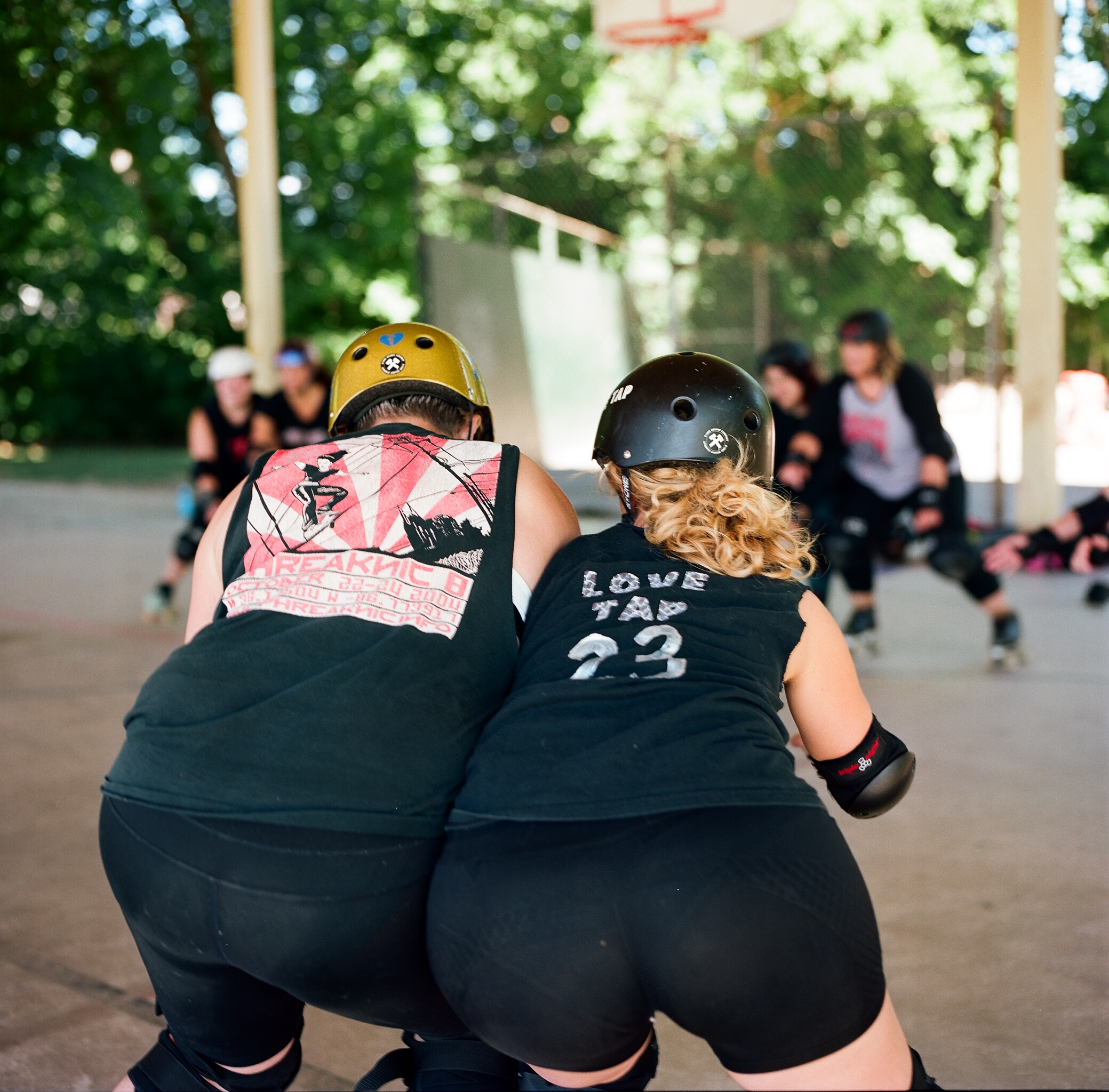Created by women and for women, roller derby has become a space for women to reclaim taboo sexualities (Geisler 2014) and pariah femininities (Finley 2010) through performance. Besides costuming, such as through decorated helmets and jerseys or the iconic short shorts and fishnet stockings, skaters form these identities by choosing and embodying a skater name. These names are not trivial; Lee Ann Epstein writes that your skater name “is likely to stick with you for life” (2009: 156), influencing not just your confidence on the track but off it as well.
For many skaters, roller derby isn’t just a hobby. Tear O’Bite, pictured here demonstrating a block with Love Tap during a Texas Rollergirls (TXRG) Recreational League practice, explains that derby is an “all-consuming passion.” Skaters sometimes work two, three jobs in order to pay for all their own gear and travel. Derby is an effective stress-reliever for many who work emotionally taxing jobs, not just because of the sport’s physical exertion but because of its camaraderie. In order to play safely—and well—skaters have to be aware of each other’s and their own bodies at all times. Failing to do so can mean severely injuring yourself or someone else. Without that trust, you can’t play a good game. Thus, creating a strong name, which in turns strengthens you, is intrinsically tied to your relationship with your teammates. Many of the skaters created their names with the help of another skater, often during a difficult time in their lives. These names seal their identities within the league and outwards. Rail Gun settled on her name after going through a period of depression. A fellow skater told her she needed a “really strong, powerful name,” and so together they chose Rail Gun, a military grade weapon. Playing derby has continued to build her confidence and help her, as she put it, redefine herself.
Of all the moments I captured during my research with the TXRG Recreational League, this one remains a favorite. Working with a bulky medium format camera, often in less than perfect lighting conditions, meant that it was difficult to capture the skaters in motion during their practices. I instead lay in wait for moments of stillness, which allowed me to focus on the intimacy between players—their trust of each other’s and their own bodies. Shooting on film, I rarely had the chance to snap multiple frames of the same scene; additionally, I was forced to crop in camera. The framing then, of the two pairs just beyond Tear O’Bite and Love Tap’s respectively helmet-ed heads, was a coincidence of timing. Their stillness was a product of carefully placed skates, hunkered down bodies, their weight pressing into each other. As I positioned my camera, Tear O’Bite explained how vital this move was. One misplaced limb, one weak link, meant a jammer breaking through your wall, scoring a point for the opposing team. In derby, your individual strength really means nothing without collective strength. You cannot second guess yourself or your teammates when you’re racing full-speed around the track. The sport itself acts against notions of women as passive, as weak, as quiet. To play derby is to riot against the norm, to claim a space for you and for your teammates unapologetically, unafraid.
Bibliography
Epstein, Lee Ann. “Roller Derby: Transporting into Academia Lessons from the Body Slam.” Chicana/Latina Studies. Vol 9, No. 1 (Fall 2009), pp. 150-157.
Finley, Nancy J. “Skating Femininity: Gender Maneuvering in Women’s Roller Derby.” Journal of Contemporary Ethnography. Vol 39, Issue 4, pp. 359-387. 18 August 2010.
Gieseler, Carly. “Derby Drag: Parodying Sexualities in the Sport of Roller Derby.” Sexualities. Vol 17, Issue 5-6, pp. 758-776. 15 August 2014.

Commentary on Rachel Tanur's Works: Drag Queen 2